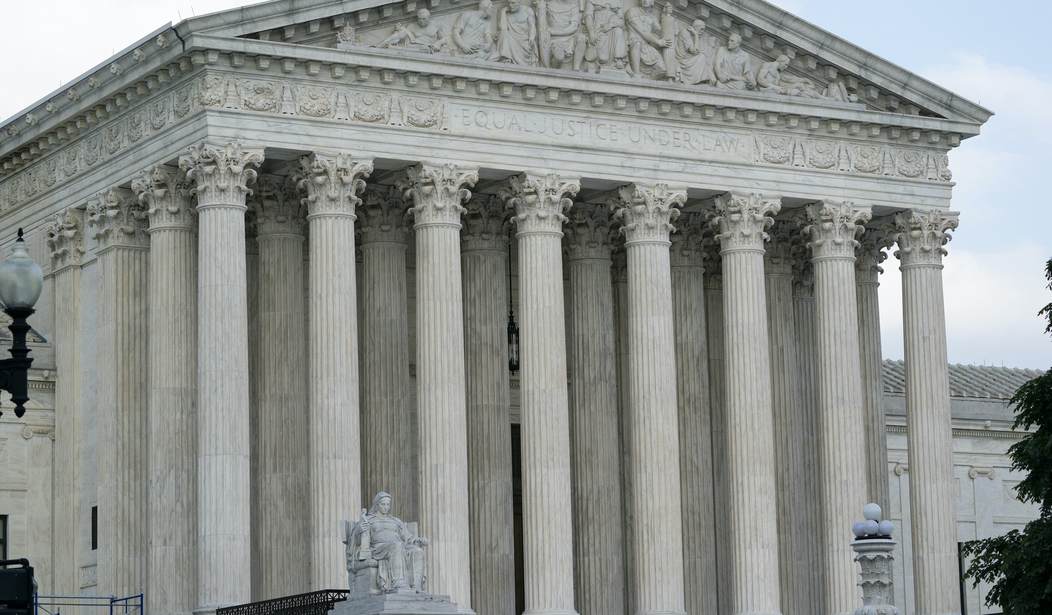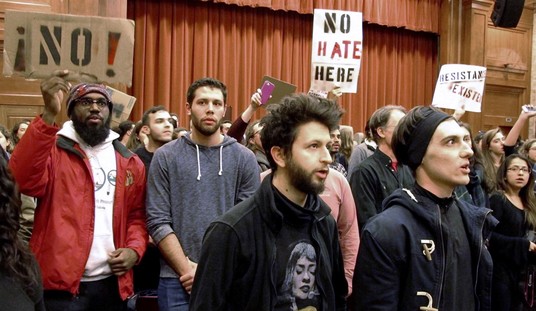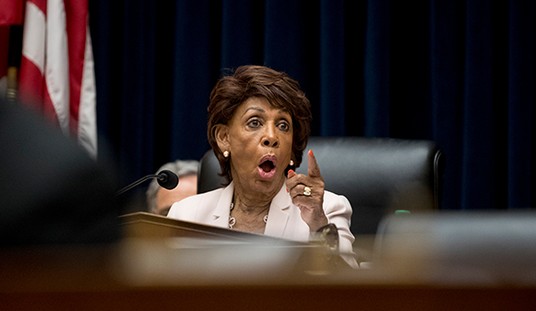Oral arguments in two cases involving affirmative action in university admissions were heard at the Supreme Court Monday. The consensus from everyone who listened to the arguments is that the six conservatives on the court seemed very skeptical of affirmative action while the three progressives were doing their best to defend it. Today law professor Ilya Shapiro has an opinion piece at Fox News arguing that the Justices should end the DEI bureaucracy on college campuses.
The man-eating plant of racialist university bureaucracy—the DEI (Diversity, Equity, Inclusion) offices whose tentacles ensnare those who deviate from progressive orthodoxy—germinated from a seed planted by Justice Lewis Powell in Regents of the University of California v. Bakke (1978). Four justices would’ve banned racial tinkering altogether, but Powell called “diversity” a compelling state interest. That conceit is now at the heart of the higher-education mission, superseding even the search for knowledge and free exchange of ideas.
A quarter-century after Bakke, a narrow Court majority in Grutter v. Bollinger (2003) codified Powell’s understanding, although swing Justice Sandra Day O’Connor expressed the expectation “that 25 years from now, the use of racial preferences will no longer be necessary to further the interest approved today.” Well, here we are nearly 20 years later, and race-conscious admissions programs have, if anything, become more ingrained and systemic.
Eventually, Shapiro discusses something that I brought up before. There’s a contradictory double-argument from proponents of affirmative action that it a) doesn’t really have much of an impact and that b) if it were eliminated the numbers of Black and Hispanic students at Harvard would drop significantly. And in discussing that, Shapiro highlighted a statistic mentioned in oral arguments that I hadn’t seen anywhere else.
On one hand, race is only one of many factors that colleges consider—and not supposed to be determinative. On the other, if using race were outlawed, the number of non-Asian minorities at selective institutions would plummet; Waxman conceded that 45 percent of blacks and Hispanics got into Harvard due to racial preferences.
That’s a pretty striking statistic. Almost half of Black and Hispanic students got into Harvard because of racial preferences? Could that be right? If so, why hadn’t I seen that reported anywhere else. Looking around today I see that Vox did mention it in passing:
They also argue that Harvard engages in “racial balancing,” a practice that they say occurs when a school seeks some specific percentage of a particular race. They also allege that Harvard doesn’t treat race as merely a plus and that “Harvard is obsessed with race,” since it “matters more than every other diversity factor” in an application. According to the petitioner, race is a “determinative” element for at least 45 percent of admitted Black and Hispanic students, or nearly 1,000 students during a four-year period.
Notice how Vox’s description differs. They are describing what the plaintiffs in the case are claiming to be true. But according to Ilya Shapiro, this is something that Harvard’s own lawyer, Seth P. Waxman, has admitted is true. So which is it?
I turned to the transcript of the oral arguments which is now posted on the Supreme Court’s website. The 45% statistic was mentioned twice. The first time came in an argument between Justices Barrett, Kagan, Sotomayor and the attorney for Students for Fair Admissions, Cameron T. Norris. As you’ll see, Sotomayor is confused about when someone’s race can be a factor in admissions and Norris keeps arguing that it should not be a factor in either direction.
JUSTICE BARRETT: But I guess, you know, in our earlier argument, Justice Kagan pointed out that this gets to be slicing the salami pretty finely. I mean, it’s one thing to say, yes, that shows resilience because you’ve written about overcoming discrimination, and a student could write about any number of obstacles that they’ve overcome, from physical disabilities on down the line.
But what if — you know, Justice Jackson had asked in the last argument, you know, about pride. What if a — what if an applicant wrote an essay about how integral their racial identity was to them as a source of pride and the cultural attributes of the racial heritage were very important? Would that be okay even if it were all intimately tied up, say, with, you know, the traditions of a Mexican family? And — and if the answer is no, that can’t be extricated from race, why would that be different than someone writing about how important it was to them to have this passion
for music in their life, that they loved music?MR. NORRIS: I think culture, tradition, heritage are all not off limits for students to talk about and for universities to consider. They can’t consider that — they can’t read that and say, oh, this person is Hispanic or black or Asian, and, therefore, I’m going to credit that. They need to credit something unique and individual in what they actually wrote, not race itself.
JUSTICE SOTOMAYOR: I — I’m — I’m a little confused because this almost sounds like a different kind of viewpoint discrimination. And under our strict scrutiny standards, we’re not supposed to discriminate on the basis of viewpoint or discriminate on the basis of religion. They’re considered as sacrosanct, I believe, as race.
And yet what you’re suggesting is that the viewpoint that somehow being a minority that overcomes discrimination in the way you define it as important as overcoming obstacles, that that’s okay, but if you’re a black person who’s from an affluent family who may be the only class president ever in a white school’s history, that that fact shouldn’t feature.
That’s a form of viewpoint discrimination, isn’t it?
MR. NORRIS: I don’t think we’re saying —
JUSTICE SOTOMAYOR: That that’s not overcoming any kind of obstacle?
MR. NORRIS: We’re not saying that universities have to consider anything or nothing. Universities just cannot consider race itself.
JUSTICE KAGAN: But I thought you were saying that both of those essays might be entirely appropriate for the university to consider, is that correct?
MR. NORRIS: Correct.
JUSTICE KAGAN: Or did I misunderstand what you were saying?
MR. NORRIS: No, there is no federal statute about what essays universities consider. There’s a federal ban on consideration of race itself.
JUSTICE SOTOMAYOR: So — so why is it — are you just objecting to touching a box that admissions officers can look at?
MR. NORRIS: We’re objecting to the use of race as either a plus or a minus in making admissions decisions.
And here’s where we come to the crux of the issue. Justice Sotomayor denies that “checking the box alone” is what got anybody in. [emphasis added]
JUSTICE SOTOMAYOR: But I don’t think you — I think the district court made very clear findings that checking the box alone is not what got anybody in —
MR. NORRIS: That there’s a —
JUSTICE SOTOMAYOR: — that it was a holistic enterprise that looked at everything that that candidate did and race might have been one among many factors, because there’s a lot of
Hispanics and blacks who have higher — higher GPAs than many whites who don’t get admitted. So they’re not looking at just being black and white. They’re rejecting a lot of the
10 percent applicants who have higher numbers than, I guess, whites and Asian Americans.MR. NORRIS: Your Honor, there’s a finding from the district court in our favor at page 116 of the Petition Appendix that Harvard can award a racial preference based on the check box alone, whether or not an applicant writes about it or otherwise indicates that it’s important to them. And that is important. That’s race itself.
JUSTICE SOTOMAYOR: Well, that — that — that finding was made in — in an undisputed finding by the district court that race alone did not account for any one admissions package, that it was race among many factors.
MR. NORRIS: Well, the district court found that race is determinative for 45 percent of blacks and Hispanics who get into Harvard. So, yes, there’s 55 percent who would not get in —
JUSTICE SOTOMAYOR: I’ll let Mr. Waxman debate that because that’s not the way I saw that record. It was very clear that the district court found, for example, that being Asian or not being Asian wasn’t involved statistically in any amount — in any of the admissions, whether for ADLCs or for non-ADLCs.
MR. NORRIS: Well, I — I just want to be clear, the 45 percent number is when race is determinative for blacks and Hispanics. That’s the number of applicants who it’s determinative for.
Our number was much higher. That’s not my number. That’s Harvard’s number in their race-neutral alternatives report.
Notice that Justice Sotomayor says she’s going to let Mr. Waxman, the lawyer for Harvard, handle that. And eventually, much later, he did mention it, though not in the way Justice Sotomayor probably hoped. Here’s Waxman talking about Harvard’s efforts to find race-neutral alternatives to improve diversity (i.e. ways other than affirmative action). [emphasis added]
WAXMAN: And there were — there were a bunch of other things in the record about things that Harvard has done, some of which have had substantial success. And so the notion that
Harvard is doing things the same way and is always going to do the same things the same way is just wrong.Harvard is — Harvard completely recognizes and endorses this Court’s statement in Grutter that “there are serious problems of justice connected with the idea of preference itself.” That’s why it holds itself — why it is attempting to achieve all of the compelling benefits of — of a genuinely diverse student body in the most race-neutral way that it can.
And in terms of — I don’t know if this is the first part of your question, but Harvard is actually attempting — is measuring how it is doing in terms of diversity and the benefits of diversity and what needs to be done and what other things can be done in a race-neutral way on a very regular basis.
And I can give you the data on — you know, with respect to either, but, for example, Harvard — there is a — Harvard said, committed itself, in 2018 that it would, you know, continue to look for race-neutral alternatives and have another systematic review, you know, systematic, statistically, you know, rigorous review about how it is doing.
That committee has been formed and has already met for the five years that will — you know, that will transpire next year. Yes, we are trying. Yes, we have tried other things that have helped. Are we there yet? No. And that’s the reason why the 45 percent, the district court’s finding of 45 percent. That’s what it shows. It shows —
JUSTICE KAGAN: Thank you.
It does sound as if Waxman is conceding that figure. He’s saying that in the absence of other successful ways to create diversity “that’s why” the 45% figure exists. At least that’s how it sounds to me. If he were about to argue the figure is incorrect we’ll never know because Justice Kagan quickly cut off what was, admittedly, a very long answer (I’ve only grabbed the end of his answer which went on for several pages).
In any case, it appears Ilya Shapiro is correct that this statistic was raised and that Harvard’s attorney conceded the point. If that’s true, why hasn’t this been more widely discussed? It seems pretty central to the idea that affirmative action is benefiting a lot of Black and Hispanic students at the expense of students who might otherwise be accepted based on factors apart from race.







Join the conversation as a VIP Member